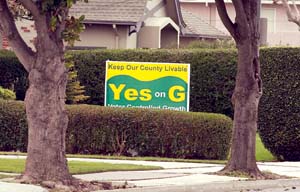With the March 2 election less than two weeks away, emotions
over the controversial county growth control initiative, Measure G,
are running as high as ever.
Arguments between those in favor and those against the
initiative have swung back and forth for months now.
With the March 2 election less than two weeks away, emotions over the controversial county growth control initiative, Measure G, are running as high as ever.
Arguments between those in favor and those against the initiative have swung back and forth for months now.
But proponents of the measure say they are still committed and feel optimistic about leaving the measure’s fate in the voters’ hands.
“The voters in Hollister passed Measure U a year ago, the growth control in Hollister, overwhelmingly,” said Richard Saxe, one of the drafters of the initiative and part of the Citizens for Responsible Growth. “The voters want growth control.”
Some principle arguments against Measure G state that the growth problem is in the City of Hollister, not the county, and that the initiative does nothing to quell the city’s rampant growth.
The current growth control-driven Board of Supervisors, who have turned down more than 25,000 applications for new homes and several different projects in the last 10 years, will be changing March 2, said Mark Levine, another drafter of the initiative and member of the Citizens for Responsible Growth.
A new Board could allow for more growth, and Measure G would put those important decisions in the hands of the voters rather than a group of supervisors, Levine said.
Opponents have also decried the measure for taking away property rights, and affecting their ability to leave land to future generations.
“You’ve got 100 acres, it’s a farm. You break off five acres for your children, you break off five acres because it’s rough times … what you end up with, instead of a 100-acre farm, is 20 five-acre ranchettes,” Saxe said. “Where is the farm? The farm is gone. There is no more farm land to farm.”
Opponents have said the measure will affect property taxes, packing plants will close, jobs will be lost and schools will lose money. All these arguments are without merit, Saxe said.
“It’s an absurd lie,” Saxe said. “They throw out all these different lies and people are confused. They’re doing a good job of confusing people.”
The bottom line is that Measure G safeguards the long-term future of San Benito County, said Janet Brians, another drafter of the initiative and member of the responsible growth group.
“It won’t be what we hope if we don’t pass Measure G and put in place the controls that are needed,” Brians said.
The group states that Measure G will set a collective, sustainable growth limit of 2 percent per year and that it puts the ability to raise the limit solely in the hands of the voters.
They also say it would help preserve agricultural lands by prohibiting the division of land into parcels too small to profitably put to good agricultural use, and basically preserves the enjoyable quality of life county residents currently have.
The rift the measure has created between county residents is not the first time an initiative involving growth has done so, Saxe said.
In 1996, two measures for the City of Hollister and the county, L and M, were proposed that created the same kind of havoc, he said.
“There was the same ugly mess. It got really bad and names were called, people were threatened,” he said. “They said the property taxes were going to go down, we cannot limit growth, and look what happened to Hollister.”
When the group penned the initiative, people who had experienced the backlash from Measures L and M warned them of the consequences of such actions, Brians said.
“I don’t think I quite believed them that it could get this nasty and vicious,” she said. “I’m really surprised at what comes out of people’s mouths and pens.”
People against the initiative are obviously not slow growth proponents, with ulterior motives to want the measure defeated, Saxe said.
“They have a monetary interest,” he said. “They don’t want growth control. These people want to develop and make money, and lots and lots of it.”
In the following days, the group will continue championing their cause by walking precincts, calling residents, sending out mailings and giving presentations at public forums.
They feel confident voters will see it their way.
“Why are we here?” Saxe said. “What is it that we’re fighting for? What is it that we have to gain? We care about the future of San Benito County – that’s the reason we’re here.”
To read the complete Measure G document, visit www.freelancenews.com










